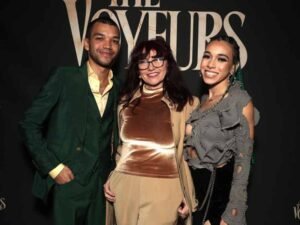Garfield Hackett: A Cultural Visionary Driving Creative Innovation and Social Change

Garfield Hackett is a highly respected figure in the British creative and cultural sectors, known for his transformative work in arts, urban regeneration, community building, and cultural equity. With a career spanning over two decades, he has been instrumental in shaping how creativity intersects with community needs and social justice. Through a diverse portfolio of projects, collaborations, and institutions, Hackett has made a lasting impact on how arts and culture are used to bring about real-world change, particularly for marginalized and underrepresented communities.
Rather than confining himself to a single discipline, Garfield Hackett operates at the crossroads of art, innovation, architecture, urban planning, and activism. His work constantly challenges traditional narratives and opens new pathways for emerging talent and community-led development.
Early Life and Inspirations
While much of Garfield Hackett’s public work is widely documented, his personal history and inspirations remain rooted in cultural advocacy, community solidarity, and a profound belief in creativity as a tool for empowerment. His early experiences growing up in environments where representation and equity were lacking deeply influenced his worldview.
Driven by a desire to change the narrative for marginalized communities, especially Black creatives in Britain, Hackett gravitated toward creative industries with the goal of making them more inclusive and representative. He understood that many talented individuals were often overlooked due to systemic barriers and lack of access. This inspired him to develop platforms, spaces, and programs that enable creative expression and community-led innovation.
Co-Founding Something & Son
One of Hackett’s major achievements was co-founding Something & Son, a London-based collaborative art and design studio focused on innovation at the intersection of architecture, sustainability, and community development. This initiative reflects Hackett’s multifaceted vision — combining art, design, and ecological systems to create experimental yet practical projects.
The collective gained acclaim for projects such as Farm:Shop, where a former shop in Dalston was transformed into a functioning urban farm. Chickens, fish tanks, and vegetable gardens were integrated into a retail space to reimagine how city dwellers engage with food and farming. Through this project, Hackett and his co-founders demonstrated how underused urban spaces could be repurposed in innovative ways that benefit communities.
Another notable initiative from Something & Son is Peckham Palms, a project that supports Black female hair and beauty entrepreneurs by offering them a purpose-built retail space in South London. The project not only supports local economic development but also challenges conventional gentrification models by putting community needs first.
Establishing The Grown Zone
Garfield Hackett’s role in developing The Grown Zone further underlines his commitment to nurturing Black creative excellence. Located in Brixton, The Grown Zone was designed as a development and co-working space specifically tailored for Black creatives and cultural practitioners. This initiative aimed to provide a safe and supportive environment for artists to grow their craft, collaborate, and build sustainable careers.
The Grown Zone wasn’t just a workspace — it was a response to the lack of dedicated spaces for Black talent in the UK. Hackett recognized that access to resources, mentorship, and networks was vital in helping new voices emerge. By curating this space, he provided tools, guidance, and inspiration to the next generation of creative leaders.
Championing Cultural Equity
A recurring theme in Garfield Hackett’s work is cultural equity. He has long argued that diversity in the arts should go beyond tokenism and instead foster systemic inclusion and power-sharing. His projects consistently highlight voices that have been historically excluded from cultural production, curatorial leadership, and public funding.
Hackett has worked with institutions, councils, and arts organizations to push for genuine inclusion in programming and leadership. Through policy advising, speaking engagements, and program curation, he has helped reshape how institutions think about representation, funding, and audience engagement.
His advocacy extends to educational institutions as well. Hackett has mentored countless young people, offering them guidance on navigating the creative industry and breaking down structural barriers that limit success for underrepresented artists.
Role in Urban Regeneration and Creative Placemaking
Garfield Hackett has also been at the forefront of urban regeneration projects across London. But unlike many traditional regeneration efforts that displace local communities, Hackett’s approach is rooted in creative placemaking — using art and design to foster community resilience, celebrate cultural identity, and create inclusive public spaces.
In Hackett’s model of regeneration, local voices are central to the planning and execution. This includes engaging residents in dialogue, hiring local talent, and ensuring that creative developments reflect the histories and cultures of the neighborhoods they serve.
By reclaiming derelict buildings and underused sites, Hackett has transformed numerous spaces into cultural hubs that serve as catalysts for social and economic growth. His work proves that creativity can be a powerful engine for community empowerment and sustainable urban development.
Collaborations and Strategic Influence
Beyond his own projects, Garfield Hackett has contributed his expertise to national and international institutions. He has collaborated with the Greater London Authority, Arts Council England, and numerous local councils on cultural strategy, policy development, and project management.
His strategic insight has made him a sought-after advisor in fields such as public engagement, diversity frameworks, and creative economy development. Hackett’s influence can be seen in various programs aimed at increasing access to arts funding, improving cultural infrastructure in underserved areas, and supporting grassroots organizations.
Mentorship and Legacy Building
One of Garfield Hackett’s most enduring contributions is his dedication to mentorship. Over the years, he has worked with hundreds of young artists, producers, and creative entrepreneurs, helping them develop their skills and navigate a competitive industry.
His legacy isn’t only defined by the physical spaces or events he has produced, but also by the lives he has impacted. Many of his mentees have gone on to create their own successful careers, citing Hackett’s guidance and belief in their potential as instrumental.
Hackett’s approach to mentorship is holistic — combining artistic feedback, emotional support, and professional development. He understands that many creatives face not only career challenges but also mental and emotional barriers, especially in environments where they feel underrepresented or undervalued.
Philosophy and Approach to Creative Work
Garfield Hackett’s work is driven by several core principles:
-
Community First: All projects are built around the needs, desires, and voices of local communities.
-
Art as Activism: Creativity is not just for aesthetics; it is a tool for dialogue, resistance, and change.
-
Sustainable Innovation: Projects must be environmentally, socially, and economically sustainable.
-
Representation Matters: Cultural spaces must reflect the full spectrum of society — from who creates, to who benefits.
These principles guide every aspect of Hackett’s work and have helped him build trust across diverse communities, from grassroots activists to institutional leaders.
Continuing the Mission
Even as trends in the creative industry evolve, Garfield Hackett remains a constant force of innovation and integrity. His recent work continues to explore how creativity can solve contemporary challenges such as racial inequality, environmental crisis, and digital disconnection.
Whether it’s advising on future-facing cultural policies, producing public art that reflects Black British history, or mentoring the next creative disruptor, Hackett remains committed to pushing boundaries and nurturing new paradigms.
Read also: Emma Michell Accounting: A Comprehensive Guide to Trusted Financial Services
Conclusion
Garfield Hackett is not only a prolific creative producer and cultural strategist but also a powerful advocate for equity, inclusion, and social justice in the arts. His projects have redefined what it means to engage communities through creativity and have shown that real change comes from within — when local voices are heard, empowered, and celebrated.
From founding Something & Son to establishing The Grown Zone, from reshaping urban spaces to mentoring young artists, Garfield Hackett’s contributions are profound and far-reaching. In a world that increasingly needs leaders who are bold, thoughtful, and visionary, Hackett continues to shine as a cultural pioneer paving the way for a more inclusive creative future.













Post Comment